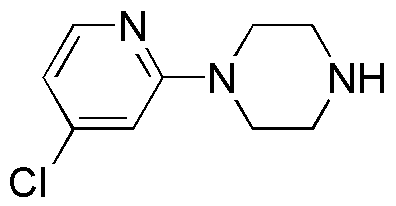1-(4-Chloropyridin-2-yl)piperazine trihydrochloride is widely utilized in research focused on:
- Pharmaceutical Development: This compound serves as a key intermediate in the synthesis of various pharmaceutical agents, particularly in the development of drugs targeting neurological disorders.
- Biochemical Research: It is used in studies related to receptor binding and signaling pathways, helping researchers understand the mechanisms of action for certain drugs.
- Agrochemical Applications: The compound can be employed in the formulation of pesticides and herbicides, enhancing efficacy and selectivity in agricultural practices.
- Material Science: It finds applications in the development of novel materials, particularly in creating polymers with specific properties for industrial use.
- Analytical Chemistry: This chemical is utilized as a standard in various analytical techniques, aiding in the detection and quantification of related compounds in complex mixtures.
General Information
Properties
Safety and Regulations
Applications
1-(4-Chloropyridin-2-yl)piperazine trihydrochloride is widely utilized in research focused on:
- Pharmaceutical Development: This compound serves as a key intermediate in the synthesis of various pharmaceutical agents, particularly in the development of drugs targeting neurological disorders.
- Biochemical Research: It is used in studies related to receptor binding and signaling pathways, helping researchers understand the mechanisms of action for certain drugs.
- Agrochemical Applications: The compound can be employed in the formulation of pesticides and herbicides, enhancing efficacy and selectivity in agricultural practices.
- Material Science: It finds applications in the development of novel materials, particularly in creating polymers with specific properties for industrial use.
- Analytical Chemistry: This chemical is utilized as a standard in various analytical techniques, aiding in the detection and quantification of related compounds in complex mixtures.
Documents
Safety Data Sheets (SDS)
The SDS provides comprehensive safety information on handling, storage, and disposal of the product.
Product Specification (PS)
The PS provides a comprehensive breakdown of the product’s properties, including chemical composition, physical state, purity, and storage requirements. It also details acceptable quality ranges and the product's intended applications.
Certificates of Analysis (COA)
Search for Certificates of Analysis (COA) by entering the products Lot Number. Lot and Batch Numbers can be found on a product’s label following the words ‘Lot’ or ‘Batch’.
*Catalog Number
*Lot Number
Certificates Of Origin (COO)
This COO confirms the country where the product was manufactured, and also details the materials and components used in it and whether it is derived from natural, synthetic, or other specific sources. This certificate may be required for customs, trade, and regulatory compliance.
*Catalog Number
*Lot Number
Safety Data Sheets (SDS)
The SDS provides comprehensive safety information on handling, storage, and disposal of the product.
DownloadProduct Specification (PS)
The PS provides a comprehensive breakdown of the product’s properties, including chemical composition, physical state, purity, and storage requirements. It also details acceptable quality ranges and the product's intended applications.
DownloadCertificates of Analysis (COA)
Search for Certificates of Analysis (COA) by entering the products Lot Number. Lot and Batch Numbers can be found on a product’s label following the words ‘Lot’ or ‘Batch’.
*Catalog Number
*Lot Number
Certificates Of Origin (COO)
This COO confirms the country where the product was manufactured, and also details the materials and components used in it and whether it is derived from natural, synthetic, or other specific sources. This certificate may be required for customs, trade, and regulatory compliance.


